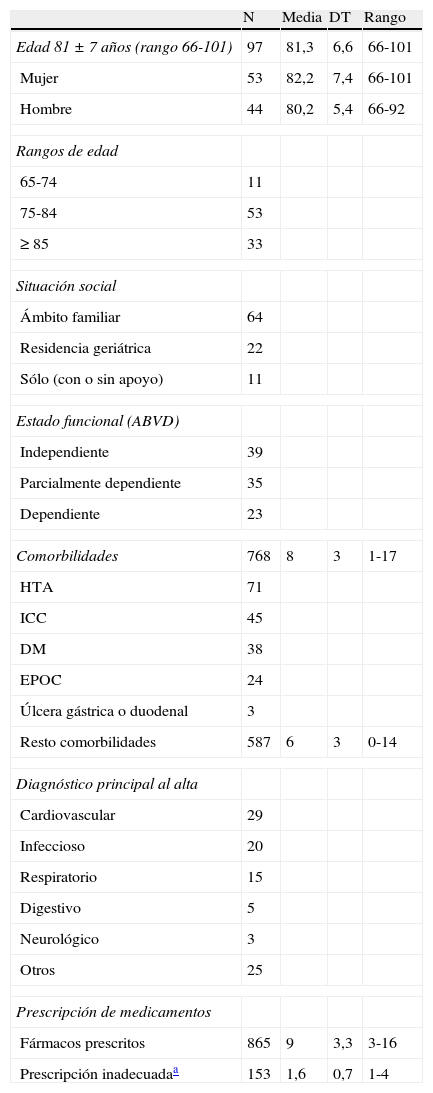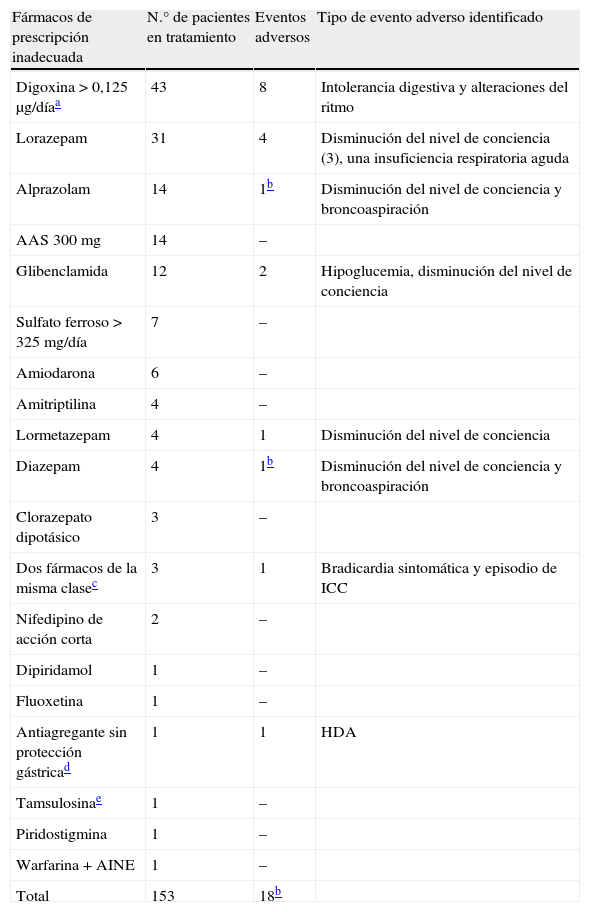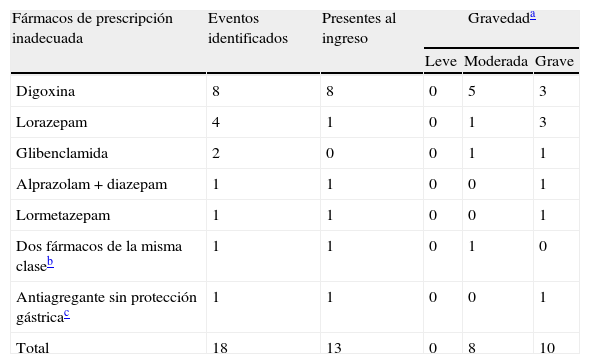La prescripción inadecuada de medicamentos se ha relacionado con el aumento de las tasas de hospitalización y la aparición de efectos adversos. Hemos examinado los fármacos de prescripción inadecuada que reciben los pacientes de edad avanzada que ingresan en el hospital, así como la frecuencia y gravedad de los eventos adversos relacionados con ellos.
Pacientes y métodoEstudio prospectivo en pacientes mayores de 65 años, ingresados en un servicio de Medicina Interna, en quienes se identificó al menos un fármaco de prescripción inadecuada (criterios de Beers y STOPP [Screening Tool of Older Person′s Prescriptions]), en régimen ambulatorio y/o en las primeras 48 de su hospitalización. La relación de los eventos adversos con los fármacos de prescripción inadecuada se estableció según el algoritmo de Naranjo.
ResultadosSe incluyeron 97 pacientes con una edad media de 81 años (rango: 66-101). El total de medicamentos prescritos durante la hospitalización fue de 865, con una media de 9 fármacos (rango: 3-16). Un 32% de los enfermos estaba siendo tratado con más de 10 fármacos. Se identificaron un total de 153 (17,7%) fármacos de prescripción inadecuada. Se produjeron 26 reacciones adversas a medicamentos, de las cuales 18 (69%) se relacionaron con fármacos de prescripción inadecuada. La digoxina y el lorazepam fueron los fármacos de prescripción inadecuada más comunes y con los que se relacionaron un mayor número de reacciones adversas a medicamentos. El 56% de estas reacciones se consideraron graves. Los pacientes institucionalizados recibían más fármacos, pero no más fármacos de prescripción inadecuada.
ConclusionesEn pacientes de edad avanzada, la frecuencia de reacciones adversas a medicamentos en relación con fármacos de prescripción inadecuada es elevada.
La implementación de estrategias para identificar las prescripciones inadecuadas y para utilizar estos fármacos apropiadamente en pacientes de edad avanzada es necesaria.
Inappropriate drug prescription (IP) has been related to higher hospitalization rates and development of adverse drug effects (ADE). We have studied the inappropriate drug prescriptions given to elderly patients admitted to the hospital and the frequency and severity of the adverse events related with them.
Patients and methodsA prospective study was conducted in a sample of 100 patients over 65 years admitted in an Internal Medicine Department in whom at least one inappropriate drug prescription (Beers and STOPP (B-S) criteria [Screening Tool of Older Person′s Prescriptions]) as outpatients or during the first 48hours after the admission. The relationship of the adverse events with the inappropriate drug prescription was established using the Naranjo algorithm.
ResultsA total of 97 patients, mean age 81 years (range 66-101) were included. The total amount of medicines prescribed during the hospital stay was 865, average of 9 (range 3-16). Thirty two percent was being treated with more than 10 drugs. A total of 153 (17.7%) were B-S drugs. There were 26 ADEs, 18 related with B-S drugs. Digoxin and lorazepam were the IP drugs most frequently prescribed and those related with a larger number of ADE. Fifty six percent of the ADEs were considered severe. Institutionalized elderly patients were treated with more drugs, but not more B-S medicaments.
ConclusionsThe frequency of ADEs related to IP is very high in the elderly. It is necessary to implement strategies to identify, and use properly these drugs in elderly population.
Article
Diríjase desde aquí a la web de la >>>FESEMI<<< e inicie sesión mediante el formulario que se encuentra en la barra superior, pulsando sobre el candado.

Una vez autentificado, en la misma web de FESEMI, en el menú superior, elija la opción deseada.

>>>FESEMI<<<








